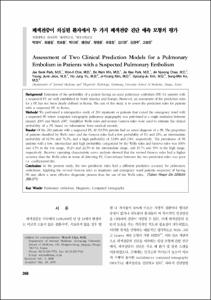KUMEL Repository
1. Journal Papers (연구논문)
1. School of Medicine (의과대학)
Dept. of Internal Medicine (내과학)
폐색전증이 의심된 환자에서 두 가지 폐색전증 진단 예측 모형의 평가
- Keimyung Author(s)
- Park, Jae Seok; Choi, Won Il; Jeon, Young June; Ko, Sung Min
- Journal Title
- 결핵 및 호흡기 질환
- Issued Date
- 2008
- Volume
- 64
- Issue
- 4
- Abstract
- Background: Estimation of the probability of a patient having an acute pulmonary embolism (PE) for patients with
a suspected PE are well established in North America and Europe. However, an assessment of the prediction rules
for a PE has not been clearly defined in Korea. The aim of this study is to assess the prediction rules for patients
with a suspected PE in Korea.
Methods: We performed a retrospective study of 210 inpatients or patients that visited the emergency ward with
a suspected PE where computed tomography pulmonary angiography was performed at a single institution between
January 2005 and March 2007. Simplified Wells rules and revised Geneva rules were used to estimate the clinical
probability of a PE based on information from medical records.
Results: Of the 210 patients with a suspected PE, 49 (19.5%) patients had an actual diagnosis of a PE. The proportion
of patients classified by Wells rules and the Geneva rules had a low probability of 1% and 21%, an intermediate
probability of 62.5% and 76.2%, and a high probability of 33.8% and 2.8%, respectively. The prevalence of PE
patients with a low, intermediate and high probability categorized by the Wells rules and Geneva rules was 100%
and 4.5% in the low range, 18.2% and 22.5% in the intermediate range, and 19.7% and 50% in the high range,
respectively. Receiver operating characteristic curve analysis showed that the revised Geneva rules had a higher
accuracy than the Wells rules in terms of detecting PE. Concordance between the two prediction rules was poor
(κ coefficient=0.06).
Conclusion: In the present study, the two prediction rules had a different predictive accuracy for pulmonary
embolisms. Applying the revised Geneva rules to inpatients and emergency ward patients suspected of having
PE may allow a more effective diagnostic process than the use of the Wells rules. (Tuberc Respir Dis 2008;64:
266-271)
Key Words: Pulmonary embolism, Diagnosis, Computed tomography
연구배경: 급성 폐색전증의 발생을 예측하는 Wells 및
Geneva 예측 모형은 서구에서 잘 확립되어 있다. 폐색전
증의 역학이 서구와 다를 것으로 보이는 국내에서의 예측
모형의 유용성에 대해서 평가 하고자 한다.
방 법: 단일 의료기관에서 폐색전증 의심 하에 multidetector
computed tomography (MDCT)를 시행한 환자
210명을 대상으로 후향적으로 조사하였다. 성별 구성은
남자 90명(42.9%), 여자 120명(57.1%)이었고, 평균 연령
은 63.3±15.9세였다. 의무기록을 바탕으로 Wells 및 개정
된 Geneva 예측 모형으로 폐색전증의 가능성에 대해 저
위험군, 중등도 위험군, 고위험군으로 분류하였다.
결 과: 폐색전증으로 진단된 환자는 210명 중 41명
(19.5%)이었다. Wells 예측 모형을 적용한 폐색전증 발병
가능성 평가에서는, 2명(1%)이 저위험군, 137명(62.5%)
이 중등도 위험군, 71명(33.8%)이 고위험군으로 분류되었
고, 각 군에서 폐색전증의 발생률은 100%, 18.2%, 19.7%271
였다. 개정된 Geneva 예측 모형을 적용할 경우 44명(21%)
이 저위험군, 160명(76.2%)이 중등도 위험군, 6명(2.8%)이
고위험군으로 분류되었고, 각 군에서 폐색전증의 발생률은
4.5%, 22.5%, 50%로 나타났다. Receiver operating characteristic
(ROC) 곡선 분석에서 개정된 Geneva 예측 모형이
Wells 예측 모형에 비해 정확도가 높았다. 두 예측 모형 사
이의 일치율은 불량했다(κ coefficient=0.06).
결 론: 본 연구에서는 폐색전증이 의심되는 환자에서
개정된 Geneva 예측모형과 Wells 예측 모형으로 평가하
여 두 모형 사이에 일치율이 불량하였으며, 개정된 Geneva
모형이 Wells 모형에 비해 폐색전증 진단 예측이 더 정확
하였다.
- Alternative Title
- Assessment of Two Clinical Prediction Models for a Pulmonary
Embolism in Patients with a Suspected Pulmonary Embolism
- Publisher
- School of Medicine
- Citation
- 박재석 et al. (2008). 폐색전증이 의심된 환자에서 두 가지 폐색전증 진단 예측 모형의 평가. 결핵 및 호흡기 질환, 64(4), 266–271. doi: 10.4046/trd.2008.64.4.266
- Type
- Article
- ISSN
- 1738-3536
- Appears in Collections:
- 1. School of Medicine (의과대학) > Dept. of Internal Medicine (내과학)
1. School of Medicine (의과대학) > Dept. of Radiology (영상의학)
- 파일 목록
-
-
Download
 oak-bbb-00138.pdf
기타 데이터 / 277.53 kB / Adobe PDF
oak-bbb-00138.pdf
기타 데이터 / 277.53 kB / Adobe PDF
-
Items in Repository are protected by copyright, with all rights reserved, unless otherwise indicated.